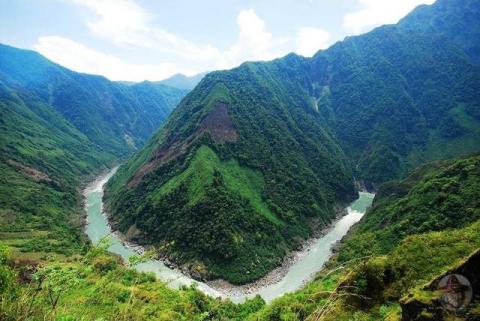This image depicts the middle reaches of the Yarlung Zangbo River which flows through southwest China's Tibet Autonomous Region. Image by Xiaohaidacong; online via Yupoo.
In the mountains of China
Where red pandas thrive;
We see dams up the river...
Will the pandas survive?
China has beautiful mountains in the southwestern part of the country. All around those mountainous areas - and their foothills - are native forests, birds, plants and wildlife.
Many people live in China, so more and more of the forest land is becoming crop land. Sometimes people clear the forest, to grow food, in a way that is called "slash and burn." Although that method is not allowed by the government, people do it anyway. Their actions are especially harmful for the land (and for the air).
Logging also diminishes China's native forests. Trees are cut-down to make furniture, paper, chopsticks, toothpicks and other things people need to live their lives. Too much logging, especially along rivers, raises the risk of flooding since trees use and hold more water than crop lands or grass.
Sometimes, when large areas of land have been cleared of native trees, a totally different environment begins to form. Wind and sun are two of the reasons for this. Higher winds can sweep across land once sheltered by trees while the sun can beat-down on areas once protected by shade. Instead of forest land, people end-up with desert land.
That is happening in parts of China.
To provide electricity for a growing population, Chinese officials in charge of land use decided to build a dam on the Yangtze River. One of China's most-famous bodies of water, the Yangtze no longer entirely follows its natural path. Part of it had to be diverted, because of the dam.
Creating the dam - which is called Three Gorges - meant that its builders had to flood land areas where people were living. Not only did many people have to leave their homes, scientists now worry that the impact of the new dam will cause uncontrollable flooding.
If uncontrolled flooding happens, mud slides and land slides could result in people and animals losing their homes or their lives - or both.
When forests are cut down, runoff from the land can turn once-clear streams muddy. Muddy streams are not good for fish or animals which use the streams as their water source.
Some of the world's most popular animals live in areas of China where deforestation is occurring. They include:
To protect the people and their land - not to mention their plants, birds and wildlife - China's government officials have created a major tree-planting program. Intended to help reforest the land, these national efforts will help the people care for - and restore - their beautiful natural resources.
Similar efforts are underway in Indonesia. Let's go there next.


 Back
Back
 Next Chapter
Next Chapter

 Back
Back
 Next Chapter
Next Chapter

